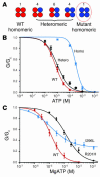ATP-sensitive potassium channelopathies: focus on insulin secretion
- PMID: 16075046
- PMCID: PMC1180549
- DOI: 10.1172/JCI25495
ATP-sensitive potassium channelopathies: focus on insulin secretion
Abstract
ATP-sensitive potassium (K(ATP)) channels, so named because they are inhibited by intracellular (ATP), play key physiological roles in many tissues. In pancreatic beta cells, these channels regulate glucose-dependent insulin secretion and serve as the target for sulfonylurea drugs used to treat type 2 diabetes. This review focuses on insulin secretory disorders, such as congenital hyperinsulinemia and neonatal diabetes, that result from mutations in K(ATP) channel genes. It also considers the extent to which defective regulation of K(ATP) channel activity contributes to the etiology of type 2 diabetes.
Figures






References
-
- Ashcroft FM, Harrison DE, Ashcroft SJH. Glucose induces closure of single potassium channels in isolated rat pancreatic β-cells. Nature. 1984;312:446–448. - PubMed
-
- Koster JC, Marshall BA, Ensor N, Corbett JA, Nichols CG. Targeted overactivity of beta cell K(ATP) channels induces profound neonatal diabetes. Cell. 2000;100:645–654. - PubMed
-
- Seghers V, Nakazaki M, DeMayo F, Aguilar-Bryan L, Bryan J. Sur1 knockout mice. A model for K(ATP) channel-independent regulation of insulin secretion. J. Biol. Chem. 2000;275:9270–9277. - PubMed

